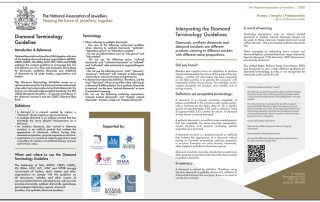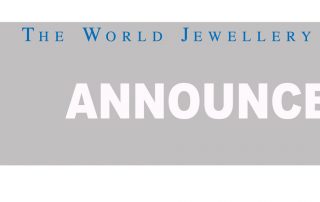About Steven Benson
This author has not yet filled in any details.So far Steven Benson has created 302 blog entries.
CIBJO President applauds decision in United Kingdom to regard Diamond Terminology Guideline as Primary Authority Advice
DECEMBER 8, 2020
Gaetano Cavalieri, President of CIBJO, the World Jewellery Confederation, has described as “profoundly important” the agreement in the United Kingdom between the National Association of Jewellers (NAJ) and UK Trading Standards, a British government service working to ensure that consumers are protected from unfair trading, to provide the Diamond Terminology Guideline the status of Primary Authority Advice.
Developed by CIBJO together with eight other leading diamond and jewellery industry organisations and first released in 2018, the Diamond Terminology Guideline is designed to serve as the reference document when referring to or describing diamonds, laboratory-grown diamonds and imitations of diamonds. It is built on two internationally accepted standards: the ISO 18323 Standard (“Jewellery – Consumer confidence in the diamond industry”) and the CIBJO Diamond Blue Book. It encourages full, fair and effective use of a clear and accessible terminology by all sector bodies, organisations, traders and retailers.
“This is a profoundly important development in what is a concerted campaign to normalise on a global basis unambiguous terminology that clearly differentiates between natural diamonds, laboratory-grown diamonds and imitations of diamonds, enabling consumers to make informed purchasing decisions,” Dr. Cavalieri said. “The collaboration between NAJ and UK Trading Standards means that consumers in a key jewellery market like Great Britain are being afforded protections now available in a limited, but still growing group of countries. Measures like this enhance confidence both in our products and in the jewellery trade itself.
The immediate effect of the NAJ-UK Trading Standards agreement is that more than 2,000 members of the association, who collectively comprise over half of the jewellery trade in the United Kingdom, have received recommendations from UK Trading Standards about describing diamonds, laboratory-grown diamonds and imitations of diamonds, based on the Diamond Terminology Guideline. By following the Primary Authority Advice, their businesses are protected against the risk of any action by enforcing authorities, even if they have a different perspective as to what needs to be done to be compliant with the law.
“By understanding the nature of the products they buy and the different value propositions, consumers are able to make informed decisions, remain confident and continue to love diamond jewellery. This is why clear and accessible diamond terminology is fundamental. In addition, as consumers increasingly get informed and shop in an interconnected digital global market, the language used across all communication channels should follow guidelines that are ideally aligned across countries,” said Raluca Anghel, Head of External Affairs and Industry Relations, Natural Diamonds Council.
With this latest development, the United Kingdom joins a group of countries that are home to important jewellery markets that have enshrined accurate diamond terminology into law. The most doctrinaire is most probably France, where a decree only allows the use of the term “synthetic diamonds,” when referring to laboratory-grown materials, and forbids the use of descriptors such as “cultivated,” “real,” and “cultured.”
In Belgium, a Royal Decree issued in November 2019 referenced the nomenclature presented in the Diamond Terminology Guidelines and the CIBJO Blue Book in listing acceptable terminology to be used by members of the jewellery and gemstone trades. It was an update of a decree that had been issued in 2014.
In Germany the ISO 18323 standard has been translated into a German DIN standard. Furthermore, the Diamond Terminology Guidelines are recognized by the German Federal Ministry for Economic Affairs and Energy as the reference documents for the diamond and jewellery trades. This followed a decision by a District Court in Munich in 2004 that relied on the CIBJO Diamond Blue Book in substantiating its decision that the term “cultured” is unacceptable for describing laboratory-grown diamonds.
China has adopted the Diamond Terminology Guidelines as reference documents for the diamond and jewellery trade, in compliance with Chinese GB/T national standards, and in the United Arab Emirates the Emirates Authority for Standardization and Methodology (ESMA) officially approved the Diamond Terminology Guidelines in November 2019.
In 2018, CIBJO and the Antwerp World Diamond Centre (AWDC) reached agreement with the Ministry of Finance of the Russian Federation to harmonise the official system used in Russia for classifying polished diamonds with the standards and nomenclature detailed in the CIBJO Blue Book.
To download the Assured Advice version of the Diamond Terminology guideline in PDF format, PLEASE CLICK HERE.
CIBJO highlights the harsh impact of COVID crisis in developing nations, in statement prepared for special session of UN General Assembly
ABOVE: Volkan Bozkır (left), President of the United Nations General Assembly, during the special session to discuss the international impact of COVID-19 and the response to the crisis, which took place on December 3 and 4, 2020. He is joined at the podium by Antonio Guterres, Secretary General of the United Nations. (Photo: UN media services)
DECEMBER 7, 2020
CIBJO, the World Jewellery Confederation, has participated in a special session of the United Nations General Assembly, which took place in New York on December 3 and 4, 2020, looking at the impacts of the COVID-19 pandemic on people, societies and economies, and discussing the multifaceted and coordinated response required to address the crisis.
CIBJO was invited to participate in the session as the jewellery and gemstone industries’ only representative in the UN’s Economic and Social Council (ECOSOC), delivering a written statement that was presented to the body on December 3 and posing a question that was addressed in the panel discussions that took place on December 4.
The COVID-19 pandemic was described as the greatest global health crisis since the creation of the United Nations 75 years ago, with fundamental humanitarian, socio-economic, security and human rights implications.To date it has claimed more than 1.3 million lives, infected more than 54 million people and upended the livelihoods billions all over the world. Significantly, it has exposed vulnerabilities and exacerbated inequalities within and between developing and developed countries, hitting the poorest and most vulnerable people particularly hard, the UN General Assembly was told.
“As was the case with almost all business sectors, the impact of the COVID-19 pandemic on the jewellery and gemstone industries presented a range of challenges that had never really been considered, let alone prepared for,” CIBJO President Gaetano Cavalieri noted in his statement to the UN General Assembly. “What was clear was that the potential fallout, both from the health crisis and its economic effects moving forward, would extend considerably beyond the luxury markets.”
“Hundreds of millions of individuals, mainly living in sub-Saharan Africa and Latin America, are dependent upon the revenues generated by the extraction of precious metals, diamonds and coloured gemstones for their livelihoods. Many of them are involved in artisanal and small-scale mining, and lack the protections afforded to employees of the larger, industrialized mining operations,” the CIBJO President’s statement continued, echoing the call made by others for special attention to be paid to countries and regions that may lack the capacity to provide relief for their citizens during the crisis.
Inequalities within and between developing and developed countries were also addressed in the question that CIBJO posed during the panel discussion. Noting the massive costs associated with purchasing, importing, shipping, handling, delivering and administering the new COVID-19 vaccines, CIBJO asked how can the international community, using multilateral cooperation, ensure that any vaccine that is developed be distributed in a full and fair way to the populations of all countries who need it, and not just the advanced Western nations. “Where will international finance come from to aid the poorest countries in vaccine distribution?” CIBJO asked.
“Although we operate in the luxury sphere, we in the jewellery and gemstone sectors have a particular perspective on the less developed regions of our globe, largely because they are the source of many of the raw materials that we use,” said Dr. Cavalieri, speaking after the UN session. “As a community we have a responsibility to serve the social and economic interests of all our stakeholders, and this is particularly acute during the type of crisis that we are all are living through, although we are not necessarily as affected to the same degree.”
To download CIBJO’s statement to the UN General Assembly, PLEASE CLICK HERE.
CIBJO releases Laboratory-Grown Diamond Guidance for review by members of affiliated organisations and companies worldwide
OCTOBER 13, 2020
The Board of Directors of CIBJO, the World Jewellery Confederation, has released a Laboratory-Grown Diamond Guidance document for review by officers and members of affiliated national associations and representatives of commercial members. This is the final stage in a more than two-year process to create a harmonised set of operating standards and principles for the laboratory-grown diamond sector.
Intended to assist all professionals handling laboratory-grown diamonds, the primary purpose of the guidance document is to protect and enhance consumer confidence. It was compiled by a committee of representatives from both the laboratory-grown diamond sector and the natural diamond sector.
A key principle of the Laboratory-Grown Diamond Guidance is that, to ensure confidence, consumers must receive complete and unambiguous information about what they are buying, so that they can make consciously informed purchasing decisions. This requires clear and accurate information that the diamonds were created industrially, and not through geological processes, as is the case with natural diamonds.
The laboratory-grown diamond sector and natural diamond sector operate according to different business models, with the relationship between colour, clarity and weight, on the one side, and rarity on the other, which exists with natural diamonds, not relevant with laboratory-grown diamonds, where colour, clarity and weight are subject to the control of the laboratory-grown diamond manufacturer. Rarity is a critical factor in setting the price of a natural diamond, and in deciding its long-term value trajectory.
Divided into various sections, the guidance document outlines clear principles for describing laboratory-grown diamonds, and well as due diligence measures that should be followed by companies handling such merchandise and events at which they are displayed, like trade shows. It furthermore recommends the manner in which loose laboratory-grown diamonds or jewellery set with laboratory-grown diamonds should be disclosed on sales invoices and consignment documents. The document also addresses the subject of laboratory-grown diamond detection technology.
A key section of the document relates to the services provided by gem labs to the laboratory-grown diamond sector. It contends that the confidence of consumers will be served by their receiving an accurate and objective report of the characteristics of the laboratory-grown stone that they are buying, but, since these are unrelated to rarity, care should be taken that the report itself does not infer a similarity between a laboratory-grown diamond and a natural diamond. The report, therefore, is referred to a “Laboratory-Grown Diamond Product Specification,” and not a grading report.
Since a manufactured product is involved, the guidance document recommends that Laboratory-Grown Diamond Product Specification reports include other information that is not provided on standard natural diamond grading reports. This includes the name of the manufacturer, the production batch, the country of manUfacture, the method of manufacture (HPHT or CVD), and information about treatments and processes to which the stone was subject after its original manufacture.
The guidance document recommends that, if the 4Cs are used by a laboratory to describe the physical characteristics of laboratory-grown diamonds, the letters “LG” should be placed as a prefix before the 2Cs of colour and clarity. Certain countries require that OIML/Legal Units of Measurement be used to describe the weight of laboratory-grown diamonds, and here the guidance document recommends that the report notes both the stone’s standard carat weight and its weight in grams.
For those wishing to review the Laboratory-Grown Diamond Guidance, the document can be downloaded in PDF format via the following link: http://www.cibjo.org/downloads/REVIEW%20DOCUMENT%20-%20CIBJO%20Laboratory%20Grown%20Diamond%20Guidance.pdf
Only officers and members of CIBJO-affiliated national associations and representatives of CIBJO commercial members are eligible to download and review the Laboratory-Grown Diamond Guidance. Therefore, the document is password protected. To obtain the password, please the contact the association to which you are connected, or the commercial member that you represent. A full list of of CIBJO national associations and commercial members is available via the following link: http://www.cibjo.org/national-organizations/
Comments about the reviewed document should be sent by email to the CIBJO Secretariat at: cibjo@cibjo.org.
Submitted comments must include the name of the person submitting them, and the name of the CIBJO national association member or the CIBJO commercial member to which they belong or they represent.
All comments should be submitted no later than Monday, November 1, 2020.




